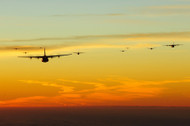US Military Propose Autonomous Robot System for Aircraft
By on Jun 6th 2016
The Air Force wants autonomous aircraft
Autonomous aircraft might not generate quite as many conversations as their autonomous car counterparts, though they are far from unheard of; in fact, advances in aviation technology and automation systems already lend to most modern planes being highly automated. Pilots spend considerably less time at the controls now during the -average- flight (the benefits of such are cited as -reduced pilot workload, improved mission prosecution, and improved flight safety-).
Many might wonder, then, if a majority of in-flight controls are manned by automated systems anyway, why not go all the way and make fully autonomous planes?
The military is thinking along those same lines, it would appear, according to a public solicitation notice that cites the following objective:
"Develop a drop-in robotic system or device to rapidly convert a variety of traditionally manned aircraft to robotically piloted, autonomous aircraft. This robotic system will operate the aircraft similar to a human pilot and will not require any modifications to the aircraft."
So we're not talking about building planes that are fully autonomous from the get-go-that would likely be an expensive and time-consuming endeavor. So rather than building a new kind of aircraft from the ground up, the project aims to leverage the existing technologies and aviation platforms and develop a -drop-in robotic system of device- that could convert already existing -traditionally- manned aircraft into robotically piloted, autonomous aircraft.
The system would essentially replace the "human" element of the pilot with a "robot" pilot, without requiring any modifications to the aircraft itself:
-Non-invasive approaches to robotically piloted aircraft using existing commercial technology and components offer the benefits of unmanned operations without the complexity and upfront cost associated with the development of new unmanned vehicles. Such a system will have the ability to automatically pilot an aircraft using only the gauges and cockpit controls available to a human pilot thus eliminating custom design and integration costs.-
Regarding the rationale of aircraft development and design, there are two big factors to consider: safety and cost.
We always want a safer plane and travel experience, and any and all options must be cost-effective, within reason. On the surface, at least, this proposal seems to satisfy both criteria by seemingly eliminating human pilot error out of the equation, as well as developing a system that should be exponentially more cost effective than designing new fully autonomous planes from scratch.
This is all rather just speculative at the moment; in order for system development, the proposal must meet a number of criteria, such as feasibility of design, ability for "human-like robotic manipulation," and capability of "vision-based recognition." Once the proposal meets such requirements, a contractor will work to develop a robot system that can manage the proposed tasks and requirements. If and when a prototype is approved, the contractor will pursue commercialization of the various technologies developed for potential government applications.
The various benefits to this system succeeding are, frankly, rather valuable, particularly if the implementation of such a system diminishes the need for a complete aircraft fleet overhaul (a costly and rather wasteful move). The elimination of pilot error is also, arguably, a plus in adding to the safety factor; however, as with many of the debates between man verses machine, there is certainly room for argument in either case. A fully automated system might cut down on eliminating human error, but then who is at fault in the event of system error? Will there be pilots in the cockpit as a precaution to override the system in the event of malfunction? The answer might not matter so much now, particularly if this technology (if successful) is limited to Air Force use--however, if this kind of technology succeeds and eventually finds its way into commercial shipping aircraft, opinions on the matter may not be so clear cut.







